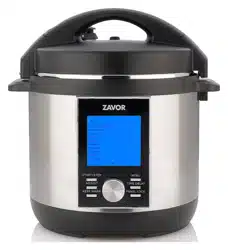Loading ...
Loading ...
Loading ...

13
12
ENGLISH
ENGLISH
standby mode.
NOTE: If you have used any of the cook assist functions prior to pressure
cooking, the cooker may require some time to come down to the proper
temperature. Once the proper temperature has been reached, the unit can
begin running the pressure cooking function.
9. Once pressure builds entirely, the unit beeps, the cooking callout appears
at the bottom of the screen, and it starts to count down. Then, your cooking
time begins. The floating valve located in the lid rises, indicating that there is
pressure inside the unit. While cooking, the function words on the panel will
blink for a majority of the cooking time. They will occasionally stop blinking for
a few minutes to indicate that the internal temperature is regulating itself. This
is perfectly normal and will not affect the performance of the cooker or the end
result of the food.
WARNING: NEVER TRY TO FORCE THE LID OPEN WHILE YOU ARE
COOKING UNDER PRESSURE, THIS CAN RESULT IN A SERIOUS
ACCIDENT.
WARNING: NEVER DEEP FRY OR PRESSURE FRY IN THE MULTI-COOKER.
IT IS DANGEROUS AND MAY CAUSE A FIRE AND SERIOUS DAMAGE.
10. When the cooking time ends, the unit beeps and switches to the KEEP WARM
function. The unit beeps periodically to let you know that there is pressure
inside the unit. Once you release the pressure, the unit stops beeping and
remains on the KEEP WARM function. Press the START/STOP button to cancel
the program.
11. After the cooking time is up, release the pressure. You have two options for
releasing the pressure:
a. Quick Release Method: Release the pressure immediately by turning the
pressure regulator knob to STEAM.
CAUTION: THE STEAM COMING OUT OF THE COOKER IS HOT, AND MIGHT
CONTAIN DROPLETS OF HOT LIQUID. BE SURE TO USE POT HOLDERS,
OVEN MITTS OR A KITCHEN TOWEL WHEN RELEASING PRESSURE.
b. Natural Release Method: Release the pressure by shutting the unit off
completely. This allows the pressure to drop naturally without turning the
pressure regulator knob to STEAM. Natural Release Method takes several
minutes, during which the food inside continues cooking. Some recipes (such
as risotto) benefit from this extra cooking time. You know when the pressure
has been released because the floating valve drops and can open the lid.
12. Once all the pressure is released, remove the lid by turning it clockwise, lifting it
and tilting it away from yourself to avoid getting burnt by any remaining steam
or hot water condensation dripping from the inner portion of the lid.
WARNING: AFTER COOKING, THE REMOVABLE COOKING POT IS HOT:
USE POT HOLDERS, OVEN MITTS, OR A KITCHEN TOWEL TO HANDLE IT
OR LET IT COOL DOWN BEFORE REMOVING.
Pressure Cooking Charts
Pressure cooking times are approximate times. Use these cooking times as a
general guideline. The amount and type of food most likely alters cooking times.
Pressure Cooking Vegetables (Fresh & Frozen): To achieve the best results
when pressure cooking fresh or frozen vegetables, please refer to the below tips
and hints:
1. Use the Vegetable setting when attempting to pressure cook vegetables. Use
the STEAM function when attempting to steam vegetables.
2. Use the quick release method when pressure cooking vegetables, so they do
not overcook.
3. Use a minimum of 1 cup of liquid when cooking vegetables.
4. When steaming vegetables, use the included Stainless Steel Steamer Basket
and Trivet.
Vegetable Pressure Cooking Chart:
Vegetable Pressure Setting Fresh (Cooking Time) Frozen (Cooking Time)
Acorn Squash, chunks High 6-7 minutes 8-9 minutes
Artichoke, 4 medium –
large
High 8-10 minutes 10-12 minutes
Asparagus High 1-2 minutes 2-3 minutes
Whole Beets, medium –
large
High 20-25 minutes 25-30 minutes
Broccoli, Florets High 2-3 minutes 3-4 minutes
Brussel Sprouts High 3-4 minutes 4-5 minutes
Butternut Squash, chunks High 8-10 minutes 10-13 minutes
Cabbage, Quartered High 3-4 minutes 4-5 minutes
Carrots, whole or chunk High 2-3 minutes 3-4 minutes
Cauliflower, florets High 2-4 minutes 3-5 minutes
Celery, chunks High 2 minutes 3 minutes
Collard Greens High 4-5 minutes 5-6 minutes
Corn on the Cob High 3-5 minutes 4-6 minutes
Edamame, in pod High 4-5 minutes 5-6 minutes
Eggplant High 2 minutes 3 minutes
Endive High 1-2 minutes 2-3 minutes
Kale, coarsely chopped High 1-2 minutes 2-3 minutes
Leeks High 2-4 minutes 3-5 minutes
Onions, sliced High 2 minutes 3 minutes
Potatoes, whole, small High 5-8 minutes 6-9 minutes
Potatoes, whole, large High 10-12 minutes 11-13 minutes
Potatoes, sliced or cubed High 5-8 minutes 6-9 minutes
Pumpkin, chunks High 4-8 minutes 6-12 minutes
Spinach High 1-2 minutes 3-5 minutes
Sweet Potatoes, cubed High 7-9 minutes 9-11 minutes
Sweet Potatoes, whole High 10-15 minutes 12-19 minutes
Tomatoes, quartered High 2 minutes 4 minutes
Zucchini High 2 minutes 3 minutes
Loading ...
Loading ...
Loading ...
